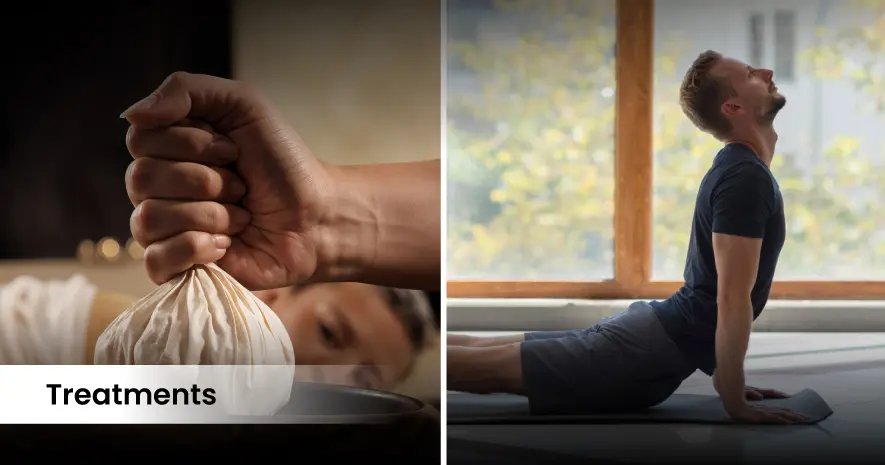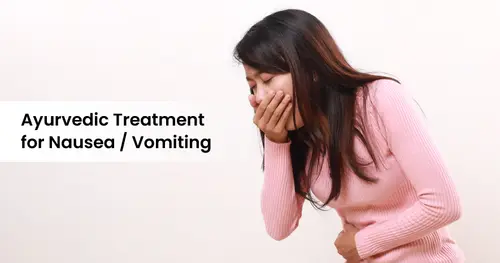
Neck pain is a prevalent musculoskeletal disorder that affects individuals across all age groups, often arising from poor posture, degenerative conditions, muscle strain, or systemic imbalances. While modern medical science primarily views neck pain through a structural and biomechanical lens, Ayurveda interprets it as a manifestation of doshic imbalance, particularly aggravated Vata dosha, which governs movement and nervous system function. The holistic nature of Ayurveda offers a multidimensional approach that not only alleviates symptoms but also corrects the underlying disharmony contributing to chronic pain. By integrating contemporary medical insights with traditional Ayurvedic principles, a comprehensive and sustainable path to managing neck pain can be established.
Etiology and Pathophysiology of Neck Pain: Modern and Ayurvedic Perspectives
Neck pain arises from multiple factors affecting the cervical spine, musculature, ligaments, and neural structures. From an orthopedic standpoint, degenerative conditions such as cervical spondylosis (osteoarthritis of the neck) contribute to progressive cartilage erosion, leading to stiffness, reduced mobility, and nerve compression. Disc herniation occurs when the nucleus pulposus of an intervertebral disc bulges outward, exerting pressure on nerve roots and causing radiating pain, numbness, and muscle weakness. Chronic inflammation from conditions such as rheumatoid arthritis or fibromyalgia can exacerbate pain through immune-mediated mechanisms.
Muscle strain is another common contributor, typically resulting from prolonged poor posture, particularly in individuals who engage in extensive screen usage, desk work, or improper sleeping positions. Whiplash injuries, caused by sudden acceleration-deceleration forces, can damage soft tissues, leading to persistent neck pain and associated symptoms such as dizziness and headaches. Cervical stenosis, or narrowing of the spinal canal, can compress the spinal cord, leading to neurological deficits alongside pain.
From an Ayurvedic perspective, Greeva Shoola (neck pain) is often associated with aggravated Vata dosha, which governs movement, dryness, and nerve function. Increased Vata in the cervical region results in muscle stiffness, joint degeneration, and erratic nerve impulses, manifesting as sharp pain, restricted mobility, and sensory disturbances. In chronic cases, Kapha dosha involvement may lead to congestion, heaviness, and impaired circulation, while Pitta dosha aggravation contributes to inflammation, a burning sensation, and increased sensitivity. Ayurveda also considers Agnimandya (impaired digestion) and Ama (toxic metabolic byproducts) as contributing factors, leading to systemic inflammation that predisposes an individual to musculoskeletal disorders.
Clinical Manifestations
The symptoms of neck pain vary depending on the underlying cause but typically include persistent pain and stiffness, which may be localized or radiate to the shoulders and arms due to nerve compression. Numbness and tingling sensations, particularly in the hands and fingers, indicate neural involvement, often caused by herniated discs or cervical radiculopathy. Headaches, dizziness, and visual disturbances frequently accompany cervical disorders due to involvement of the cervico-cranial junction and reduced cerebral blood flow. Muscle weakness and difficulty maintaining posture may develop in chronic cases, reflecting deeper structural degeneration.
Ayurvedic texts describe symptoms such as stiffness, heaviness, tingling sensations (Toda), dryness, cracking sounds (Khanja), and pain worsening at night or with cold exposure, which align with aggravated Vata dosha. If Kapha dosha is involved, individuals may experience dull, heavy pain and swelling, while Pitta aggravation can manifest as burning sensations, tenderness, and local heat. Recognizing these symptom patterns helps in tailoring treatment strategies to restore doshic equilibrium.
Ayurvedic Treatment Approaches for Neck Pain

Acute Neck Pain Management:
For acute neck pain, Ayurveda employs both internal and external therapies to provide rapid relief while addressing underlying doshic disturbances. Herbal formulations rich in anti-inflammatory and analgesic compounds play a crucial role in pain management. Haridra (Curcuma longa), known for its curcumin content, exhibits potent anti-inflammatory and antioxidant properties comparable to non-steroidal anti-inflammatory drugs (NSAIDs). Shunthi (Zingiber officinale) and Guggulu-based formulations, such as Simhanada Guggulu and Yogaraj Guggulu, help reduce inflammation and alleviate muscle stiffness.
Externally, Abhyanga (therapeutic oil massage) with Mahanarayana Taila, Ksheerabala Taila, or Dhanwantharam Taila helps pacify aggravated Vata, improve circulation, and relax tense muscles. Warm medicated oil penetrates deep into tissues, promoting musculoskeletal healing. This approach aligns with modern physiotherapy principles, where massage therapy enhances blood flow, reduces muscle tension, and improves range of motion.
Chronic Neck Pain Management:
Chronic neck pain, often associated with disc degeneration, persistent inflammation, and metabolic toxins, requires a deeper cleansing and rejuvenation approach. Panchakarma therapies, particularly Virechana (therapeutic purgation) and Vasthy (medicated enema therapy), are recommended for detoxification and Vata pacification. Virechana eliminates accumulated Pitta toxins contributing to inflammation, while Vasthy nourishes the nervous system and strengthens spinal tissues.
For individuals with muscular stiffness and Kapha-related congestion, Swedana (fomentation therapy) using Podikizhi (herbal bolus therapy), Valuka Sweda (sand therapy), and Dhanyamla Dhara (fermented liquid therapy) are highly effective in improving circulation, relaxing muscles, and mobilizing toxins. These therapies have physiological parallels with thermotherapy and hydrotherapy, both of which enhance tissue repair and reduce pain perception.
Nasya Karma, a nasal administration of medicated oils such as Anu Taila or Shadbindu Taila, is particularly beneficial for chronic cervical pain, headaches, and associated symptoms like dizziness and blurred vision. The nasal route provides direct access to the central nervous system and helps clear toxins lodged in the cervical region.
Preventing Recurrence:
Beyond immediate pain relief, Ayurveda emphasizes strengthening and preventive care through therapeutic yoga and postural corrections. Specific asanas such as Bhujangasana (Cobra Pose), Marjarasana (Cat-Cow Pose), Matsyasana (Fish Pose), and Ardha Matsyendrasana (Half Spinal Twist) enhance flexibility, strengthen spinal muscles, and prevent recurrent neck pain. Studies on yoga therapy for cervical spondylosis confirm its benefits in reducing pain severity, improving spinal mobility, and enhancing quality of life.
Ayurveda also underscores lifestyle modifications, including proper ergonomic practices, avoiding excessive screen time, maintaining good sleeping posture, and consuming a Vata-pacifying diet rich in warm, easily digestible foods. Incorporating medicated ghee preparations such as Brahmi Ghrita and Kalyanaka Ghrita supports neurological health and enhances resilience against degenerative conditions.
Neck pain, though often considered a localized musculoskeletal issue, is deeply intertwined with systemic imbalances in digestion, metabolism, and nervous function. The Ayurvedic approach to cervical pain extends beyond symptomatic relief, focusing on root-cause correction through detoxification, nourishment, and strengthening therapies. By integrating herbal medicine, Panchakarma detoxification, therapeutic yoga, and evidence-based lifestyle interventions, Ayurveda provides a sustainable and scientifically validated framework for neck pain management.
FAQ
1. What causes neck pain according to Ayurveda?
Ayurveda attributes neck pain primarily to an imbalance in the Vata dosha. Poor posture, stress, sedentary lifestyle, and degenerative changes in bones and muscles can aggravate Vata, leading to stiffness, pain, and restricted movement in the neck.
2. How does Ayurveda treat neck pain?
Ayurvedic treatment for neck pain focuses on restoring dosha balance using therapies like Abhyanga (medicated oil massage), Kizhi (herbal poultice), Nasyam (nasal administration of medicine), Greeva Basti (oil pooling on the neck), and internal herbal medications. Lifestyle and dietary changes are also recommended.
3. Can Ayurveda cure chronic neck pain completely?
Ayurveda aims at long-term relief by addressing the root cause. While it may not offer an instant cure, it provides sustainable results through detoxification, rejuvenation, and strengthening therapies. Chronic conditions may require a longer treatment duration.
4. How long does Ayurvedic treatment for neck pain take?
The duration varies based on the severity and cause of the pain. Typically, inpatient therapies may range from 7 to 21 days, with additional home-based care and lifestyle modifications for continued recovery.
5. Are there any side effects of Ayurvedic treatment for neck pain?
When administered properly under the guidance of a qualified Ayurvedic physician, treatments are safe and natural, with no side effects.

November 26, 2025

November 13, 2025

November 09, 2025

October 27, 2025

October 24, 2025

October 18, 2025
We use cookies that are necessary for the smooth operation of the website, to improve our website and to display advertising relevant to you on social media platforms and partner websites. By clicking "Accept all", you agree to the use of cookies for convenience features and statistics and tracking. You can change these settings again at any time. If you do not agree, we will limit ourselves to technically necessary cookies. For more information, please see our privacy policy .